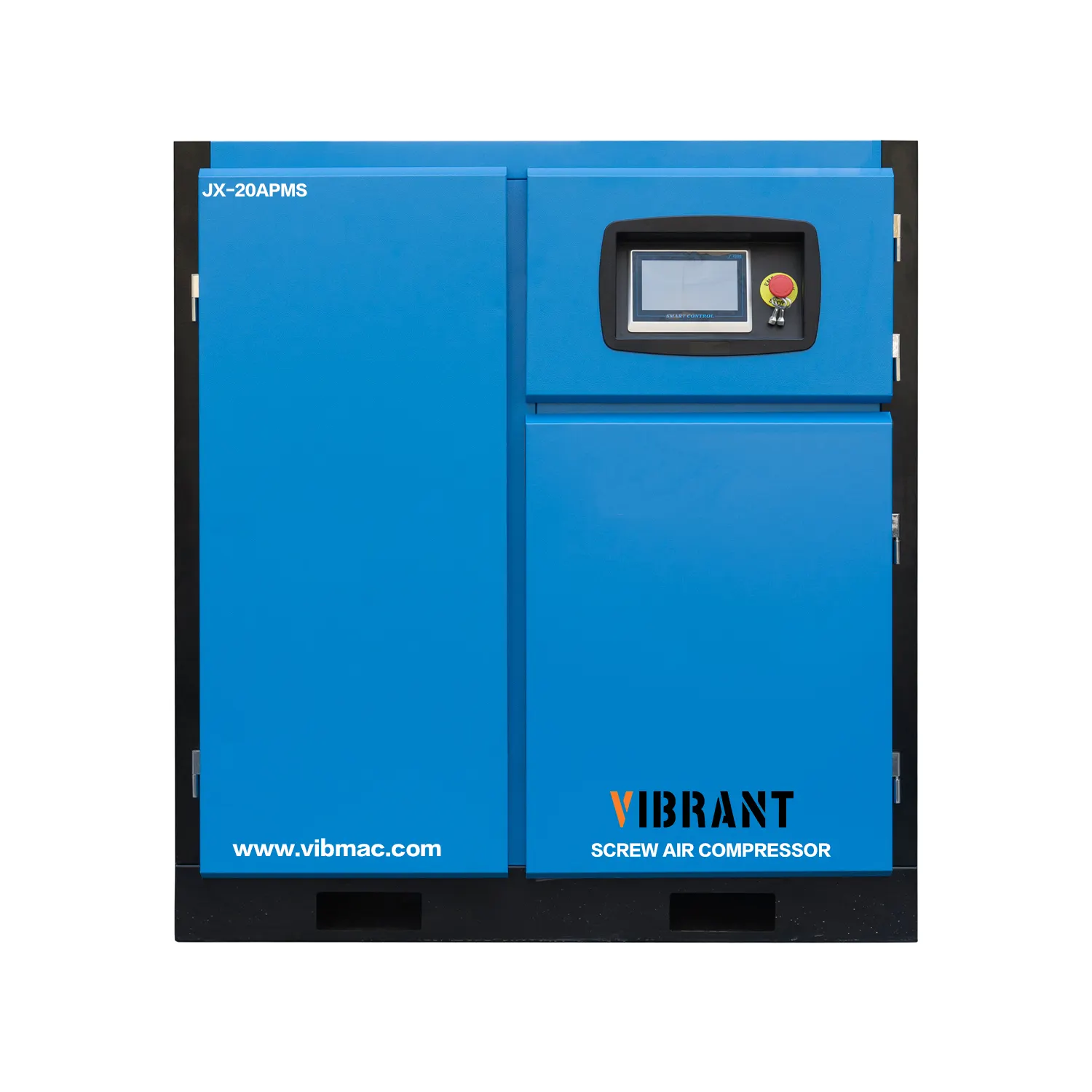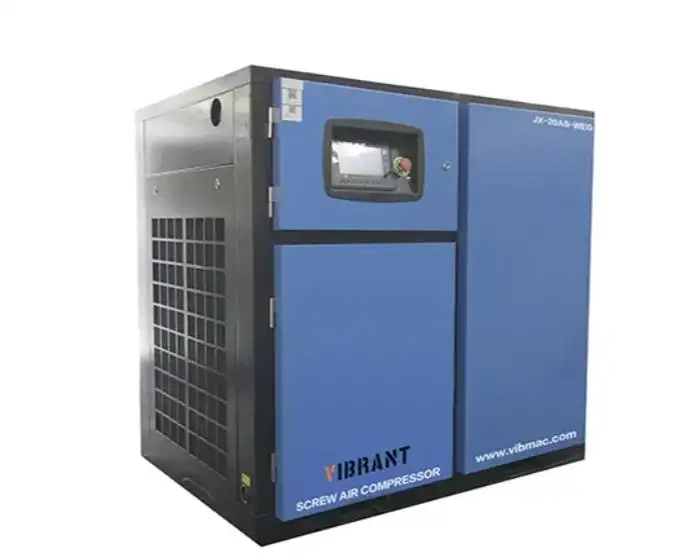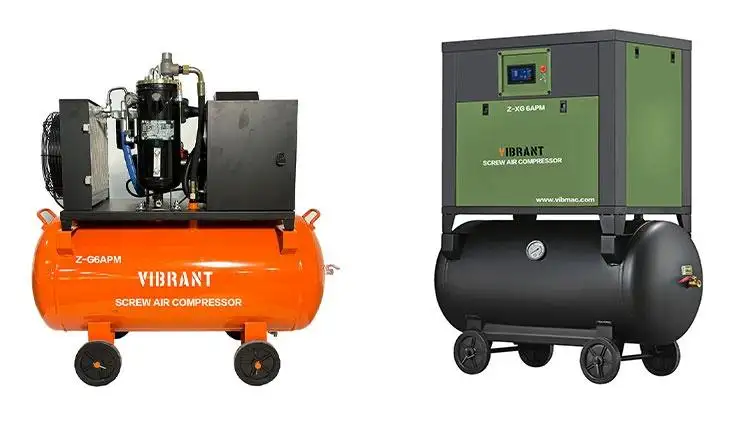
what does a compressor do? An air compressor is a machine used to compress gas to increase gas pressure, mainly used in mining, metallurgy, machinery manufacturing, petrochemical and defense industries. With the increasing application of air pressure control and pneumatic control, air compressor has become an indispensable equipment in modern industries. Based on their structural principles, the commonly used air compressors are generally categorized into two main types: piston and screw, i.e. Piston (reciprocating) compressors and rotary screw air compressors. In the long-term use of the process, we found that, compared with the piston air compressor, screw air compressor has higher stability of operation, lower energy consumption, equipment management costs are reduced, the quality of the output air has been improved, the working environment has been effectively improved.
1. How does a piston air compressor work? What is the common faults of a piston air compressor?
Piston air compressor consists of air end, after-cooling system, water circulation cooling system, lubrication system, pressure regulation system, safety system, motor, control system. The air end and the motor are fixed to the machine base with solid foundation by ground bolts. When working, it is driven by a motor, which is driven by a coupling or belt transmission system, and through the connecting rod and crosshead, the rotary motion of the crankshaft is transformed into the reciprocating linear motion of the piston. When the piston starts to move from the outer stop to the inner stop, the outside of the piston in the cylinder is in a low-pressure state, and the air enters into the cylinder through the suction valve, when the piston returns to move from the inner stop to the outer stop, the suction valve closes, and the pressure air in the cylinder is compressed and the pressure rises. When the pressure exceeds the pressure outside the exhaust valve and the spring force of the valve, the exhaust valve opens, and the compressed air in the cylinder is discharged, and when the piston reaches the outer stop, the exhaust process is completed, thus completing a working cycle. Due to the reciprocating motion of the piston, in the cylinder, alternately occurring gas expansion inhalation, compression and discharge process, so as to obtain continuous pulsation of compressed air.
In practice, the common failures of piston compressors are: (1) fracture of connecting rod bolts due to overloading or excessive preload; (2) piston jamming or cylinder pulling due to poor lubrication or cooling; (3) heating of bearings due to uneven fit of journals and shingles or small contact surfaces; (4) interruption of the water supply due to insufficient supply of cooling water or clogged cooling water lines, resulting in cylinder and cylinder head heating; (5) cylinder knocking due to worn pistons or piston rings, etc. (5) Heat generation from the piston or piston ring.
2. How does a screw air compressor work? What is the common faults of a piston air compressor?
Screw air compressor consists of screw air end, motor, lubrication system, oil-air separator, cooler, water separator, air conditioning system, safety system and electrical control box. The whole machine is generally installed in a square box, the installation can be placed directly on the level ground, do not need to be fixed with ground bolts. Screw air end is an important part, it has a pair of parallel spiral rotor which meshes with each other inside, i.e. Yang rotor and Yin rotor. The rotor rotates at a high speed driven by the motor, and as the volume between the teeth decreases, the air drawn in from the air filter is continuously compressed and the pressure rises. At the same time, the lubricating oil is constantly sprayed into the working chamber of the air end, playing a lubricating and cooling effect. When the volume between the teeth of the yin and yang rotors is connected to the exhaust port of the air end, the oil and gas mixture is discharged from the exhaust port and enters the oil-gas separator. After the oil-gas mixture from the air end rotates into the oil-gas separator, due to the mechanical centrifugal force, it rotates and hits the wall of the tank, reduces the flow rate, and forms large oil droplets, and most of the oil is separated from the oil-gas mixture. The air passes through the oil-gas separation cartridge to separate the oil mist further, and the oil separated from the oil-gas separation cartridge passes through the oil return pipe, filtered by the oil filter, and returns to the screw air end, and the separated compressed air enters the air storage tank for use.
The whole working process of screw air compressor is divided into: suction process, closure and transportation process, compression and oil injection process, exhaust process.
Screw air compressor common failures are generally: oil filter plugging cold, clogged return pipe, air filter clogging, temperature control valve element failure, temperature sensor malfunction and so on. But in practice, the screw air compressor failure is very little, as long as we do a good job for "three filters" of regular maintenance: air filters, oil filters, oil-gas separator, we can ensure its stable and reliable operation.
3. What are the differences between piston air compressor and screw air compressor?
In the actual use of a factory, VIBRANT Machinery Co., Ltd statistically analyzes the operating conditions and operating data of piston air compressor sets and screw air compressor sets.
(1) Comparison of power consumption: After measurement, the actual power consumption of piston compressor is about 6% higher than its nominal technical parameters, while the actual consumption of screw compressor is the same as the nominal technical parameters due to the high precision of its design and processing. Measuring the power consumption per cubic meter of gas compressed, screw compressors consume about 5% less power than piston compressors.
(2) Comparison of equipment management: due to the very high requirements for lubrication, piston compressors need full-time duty personnel to regularly measure the cylinder temperature, lubrication, pressure adjustment, etc.; and PM VSD screw air compressors are completely intelligent digital control, through the electronic sensors to accurately collect all kinds of data, in the process of operation, it can be set according to the pressure, running time to achieve unmanned management, the management cost is much lower than piston air compressor. At the same time, its operation process is stable and cost-effective.
(3) Comparison of maintenance costs: Because the maintenance cycle of piston compressor is shorter than that of screw compressor, piston air compressor valve, piston ring and other wear parts need cyclic maintenance; while we maintain the air filter, oil filter, and oil-gas separator of the screw air compressor only after a certain period of operation.
(4) Comparison of the quality of the gas: Oil content of the gas in screw air compressor is less than 3mg/L, much lower than the oil-free piston compressor, so that the use life of the back-end gas source processing equipment is greatly extended, protecting the pneumatic equipment and pneumatic tools.
(5) Noise comparison: As the screw air compressor has taken noise reduction measures, its noise degree and noise level are much better than the piston air compressor. Through the noise measurement of piston air compressor and screw air compressor respectively, the noise of screw is about 65dB(A), while the piston is about 90dB(A).
4. Conclusion
By analyzing the structure and working principle of piston air compressor and screw air compressor and comparing them in the process of practical application, the screw air compressor has incomparable advantages over the piston air compressor, which not only reduces energy consumption, equipment management costs and maintenance costs, but also significantly reduces the noise, so that the working environment has been improved, and the equipment runs more stably and reliably. Read more.








